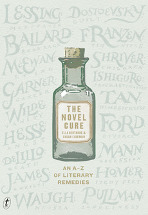The novel cure: An A-Z of literary remedies by Ella Berthoud and Susan Elberkin

Text, 2013. ISBN 9781922079350.
This book is written in praise of literature as a cure for physical
and psychological ailments. It is organised under 'ailments', which
are arranged alphabetically and include topics both serious and
comical. The authors claim that Abandonment, their first condition,
can be remediated if not cured by reading Kent Haruf's Plainsong,
which shows how characters with losses have their needs filled by
surprising contributions from their community. The last condition,
Zestlessness, it is suggested can be cured by reading Doctorow's Ragtime,
an energetic capturing of life in New York in the early twentieth
century. Some of the discussions inbetween deal with equally serious
subjects, Insomnia, Happiness, Hatred, while others are
tongue-in-cheek, for example Itchy teeth (apparently a condition
described in Saul Bellow's Henderson the rain king and which
needs to be consulted for the cure) and Idiot, feeling like an (read
Dostoyevsky's The idiot!). The headings are beautifully
organised, with cross-references that work, and concludes with an
index of authors and titles. There are also lists of recommended
reading , under the heading of 'The ten best...' These include
recommendations for audio books, novellas, 'big fat tomes', for
'drowning out snoring', for 'reading on the loo', and for each
decade from the teenage years to the over one hundreds. The
recommendations are widely based, and include classics, little known
works of the twentieth century and very up-to-date publications.
Dickens is here, Austen too, and Cervantes, and so are Suzanne
Collins, John Green, Mark Dunn and Sam Lipsyte. The writing is
lively and entertaining, and following up the cross-referencing is
enjoyable. The discussions of the texts and sometimes the ailments
are usually insightful, though classics teachers would disagree with
the characterisation of Odysseus as having 'itchy feet'. This is an
energetic and entertaining approach to reading for adults, but is
appropriate for senior students and should be very useful for
teacher-librarians and teachers of literature. It is also great fun
too for a casual browse.
Jenny Hamilton